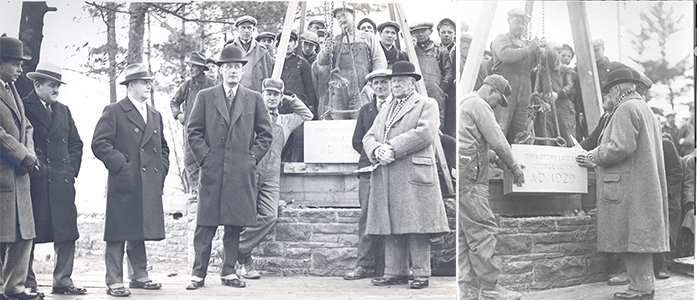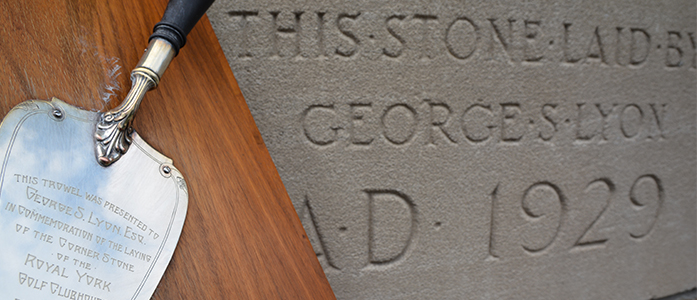Private: News
Back
-
Posted on 08.05.2016
George S. Lyon etched in stone at St. George’s

You will see George S. Lyon’s portrait hanging in the Founder’s Room across from one of Home Smith. You will find a couple of black and white photos of him in the Royal York Room among many other historic images. You can see his face amongst many in History Hall and in the corridors of the Men’s Locker Room and in the pages of the Club’s 75th anniversary book that was published back in 2004.
George S. Lyon made Canadian and Olympic golf history long before he became Chairman of the Advisory Committee of the Royal York Golf Club (now St. George’s Golf and Country Club) that spearheaded the creation and building of one of Stanley Thompson’s finest masterpieces back in 1929. It would be amazing to turn back the clock and have a conversation with George S. Lyon about the day he laid the cornerstone for the clubhouse on December 14th, 1929 along with our founder Home Smith and their friend Stanley Thompson who worked on the course from 1928 to 1930, or when he took the ceremonial first tee shot on a rain soaked day to officially open the golf course on May 19th, 1930.
“Lyon was the greatest Canadian amateur golfer of his time from 1900 through 1950 and a sporting legend who played a key role in helping Home Smith drum up support for a “pay as you play” that could not be readily reached by public transportation, bus, railway or streetcar,” says St. George’s Golf and Country Club archivist, Rick Murray. He notes that the two men were also involved in the development of the first public course in Toronto in 1920 – Humber Valley Golf Club – designed by Stanley Thompson – that closed in 1954 to make way for a sewage treatment plant! The stock market crashed in October 1929 and the following year golfers had the choice of playing the Royal York course for $3 a round or buying a yearly ticket for $65 for male members or $50 for females.
Lyon, who did become an honorary member at Royal York Golf Club, is once again in the headlines as golf is welcomed back to the Summer Olympic Games for the first time since 1904. That’s when Lyon, who was 46 years of age at the time, travelled to St. Louis, Missouri with two other members from Lambton G&CC and triumphed at the Glen Echo Club over the reigning U.S. Amateur champ, 20-year-old Chandler Egan.
What you should know about Lyon – and there’s a lot, including a new book “Olympic Lyon”, The untold story of the last (and lost) Gold Medal for Golf.” Lyon was born in 1858 in the village of Richmond, near Ottawa. He relocated to Toronto, where he raised a family of five children with his wife Annette and sold insurance for Sun Insurance Office for 37 years before retiring in 1931. He also joined the Queen’s Own Rifles of Canada in 1881, as a reservist, and served through the North-West Rebellion of 1885. He played football, hockey and tennis growing up and even held the Canadian pole vault record at the age of 18. He was also a well-known cricket player and curler, who has his name on the Canada Life Trophy and was an Ontario Tankard winner! He got his start in golf at Rosedale Golf Club, but left there to be a long-time member at Lambton Golf and Country Club, as well as The Toronto Golf Club for a few years. He’d win the Canadian Amateur eight times, among other titles, before winning gold at the Olympics. He said he played the best golf of his life finishing runner-up in the 1906 U.S Amateur. Lyon died in May of 1938 after suffering a stroke.
The very first George S. Lyon Team Championship was played in 1931 and a team from Royal York Golf Club consisting of William J. Thompson, D.W. Palmer, Hugh S. Reid and Lyon himself finished in a tie with a team from Lambton G&CC with a score of 335. It was last won by a team from St. George’s back in 1973 including; Nick Wright, John Swann, Al Cassidy and Wayne Kimura.
In his book, Golf in Canada – A History, St. George’s G&CC Hall of Fame member James Barclay wrote, “His colourful excursions in such events (the Olympics) caused pages to be written in the Canadian sporting sheets, helping to bring golf to the attention of thousands who had never heard of the game. George Lyon caught the interest and imagination of all. He is remembered as a man who played golf for the sheer enjoyment of it, as one who lived to win with deep and untrammeled sincerity, but who knew how to win graciously, how to lose gracefully. Above all, he was a man who hewed to the written and unwritten rules of the game.”
If you have never noticed the cornerstone that G. S. Lyon laid into the foundation of the clubhouse, that maybe because for many years it was covered with vines that covered the wall of the turret tower along Islington Avenue where it can now be found and is definitely worth a look the next time you’re walking by.

In fact, the trowel that Lyon used to lay the cornerstone, and can be seen in the black and white photo accompanying this article, is part of St. George’s very own George S. Lyon Trophy that is presented each year for the WAGS (Wednesday Afternoon Golfing Seniors). On the back of the trophy there’s a letter dated, October 22nd, 1976, that explains that the trowel was given to the club in 1969, by George’s son, Fred M. Lyon in memory of his father. However, in 1972 the trowel went missing and it was only found again after a search of the entire club premises revealed that the chef of the day had been using it as a spatula for the grill in the kitchen!
So when golf makes its return to the Olympics on August 11th don’t forget that George S. Lyon played both a large role in the Olympic movement, as well as the creation of what is now St. George’s G&CC – and if you happen to find an Olympic gold medal in the clubhouse let us know, because it also went missing many years ago and hasn’t been found.
